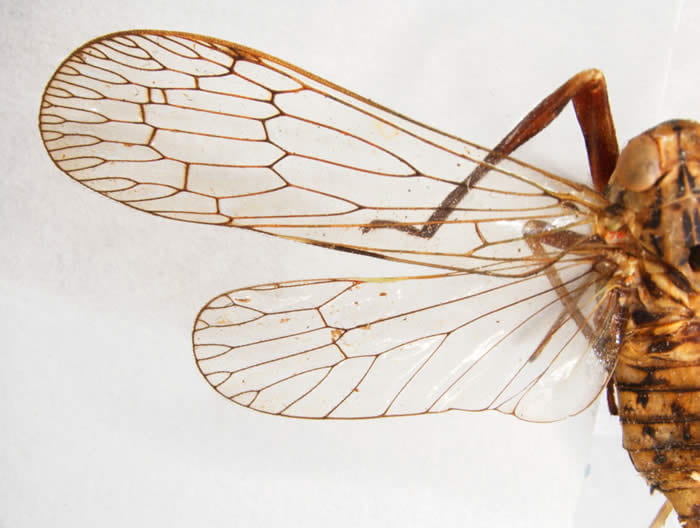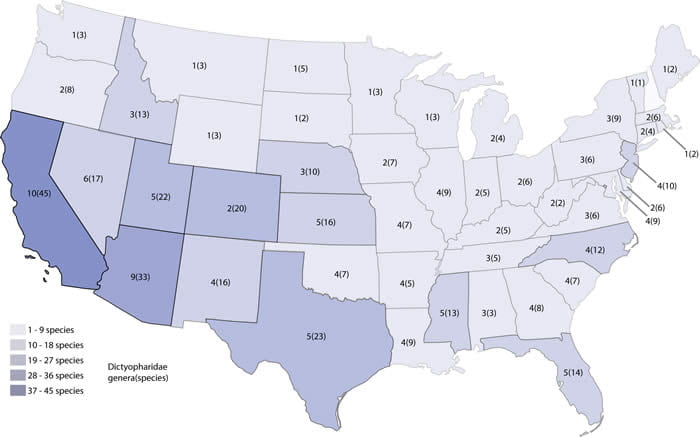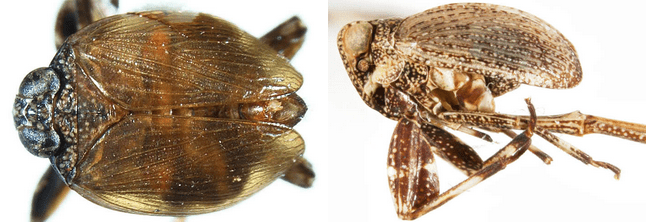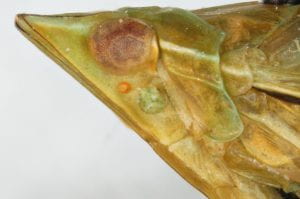Dictyopharidae is the 6th largest family of planthoppers worldwide, with 156 genera and 720 species at present (Bourgoin 2016). Dictyopharidae is represented north of Mexico by 14 genera and 85 species. The southwest includes nearly all species known from the contiguous United States (14 genera, 80 species), with the rest of the regional fauna consisting mostly of widespread taxa. Nine genera and 39 species are Orgeriinae, an unusual, brachypterous, arid-adapted subfamily, all of which are endemic to the southwest U.S. and adjacent Mexico. Among Dictyopharinae, Scolops is the most species-rich genus, including 36 taxa found in nearly all states and Mexico; Phylloscelis (4 species) is found only north of Mexico, whereas Mitrops (3 species), Nersia (12 species) and Rhynchomitra (5 species) are also found elsewhere in the Neotropics. Tribes of Dictyopharinae were recently revised by Emeljanov (2008, 2011).
Dictyopharidae and Fulgoridae are sister groups, with problematic family-level delineation, although the enigmatic taxa are mostly Old World (Urban & Cryan 2009). The families are similar in several respects, including the tendency to have an elongated head, and both having a row of teeth on the apex of the second hind tarsomere (a plesiomorphic feature for the superfamily). North of Mexico, the families can be separated by Dictyopharidae not having reticulate venation in the hind wing (see below). North American dictyopharids are usually smaller than fulgorids, but there is overlap (although U.S. fulgorids always have patterned forewings whereas the larger U.S. dictyopharids have clear wings). Many dictyopharids have 3 carinae on the frons in addition to the lateral carinae (separating the functional frons from the genal and temple region). Orgeriinae is brachypterous, as are most Scolops and Phylloscelis (although the brachypterous wings of the latter 2 genera will cover the abdomen, whereas in Orgeriinae the forewings leave several tergites exposed). Dictyopharidae is characteristically long-legged and have a long beak, and stand in a curious upright position to feed.
Since Metcalf (1946), Phylloscelis has been revised (McPherson 1994, McPherson & Wilson 1995), and Doering (1955) revised Acinaca and Deserta, providing a key to genera of North American Orgeriinae. Since few species of Dictyopharidae have been described from North America since Metcalf (1946), earlier taxonomic works are still useful, including Doering & Darby (1943) for Orgerius. Breakey (1929) provides a key to Scolops, but 12 taxa have been described since that time, and a synthetic work is badly needed. Fennah (1944) presented keys to most of the New World dictyopharid genera. The key is revised from Doering & Darby (1943) and Fennah (1944), with Loxophora and Timodema treated as subgenera ofTicida following Emeljanov (2006).
Dictyopharids feed on a variety of plants with adults and nymphs both found on above-ground portions of plants. Most species are associated with dicots in a variety of plant families, and are most often reported as monophagous (Wilson et al. 1994). The biology of Nersia florens was described by Wilson and McPherson (1981a). This species (in Illinois) is apparently univoltine, and feeds on Rumex crispus L. (Polygonaceae) and Ageratina altissima (L.) King & H. Rob. (Asteraceae), with adults emerging in August and September. The biology of Phylloscelis was examined by McPherson (1994) and McPherson & Wilson (1995, 1996). Phylloscelis is also univoltine (except Florida populations of P. atra), and overwinters as eggs. Phylloscelis pallescens was found exclusively on Pycnanthemum tenuifolium Schrad. (Lamiacae) with nymphs producing abundant wax. Phylloscelis rubra (the ‘cranberry toad bug’) is reported only from cranberry (Vaccinium macrocarpon Aiton; Ericaceae) and has been implicated in wilting and dieback (Sirrine & Fulton 1914, Wilson & O’Brien 1987). Taosa inexacta (Walker 1858) is being considered as a biological control for water hyacinth (Eichhornia crassipes(Mart.) Solms, Pontederiaceae; e.g., Cordo 1999). Rhynchomitra microrhina was recently reported from the exotic grassEragrostis curvata (Schrad.) Nees and appears to be bivoltine (Wilson & Wheeler 2005).
The genera of Dictyopharidae found north of Mexico are as follows:
Dictyopharinae Onuki, 1901
Nersiini Emeljanov 1983 (sensu Emeljanov 2011)
Mitrops Fennah, 1944 (Type species Fulgora noctivida Linnaeus, 1767).
Nersia Stål, 1862 (Type species Nersia haedina Stål, 1862).
Rhynchomitra Fennah, 1944 (Type species Dictyophara microrhina (Walker, 1851).
Phylloscelini Emeljanov, 1983
Phylloscelis Germar, 1839 (Type species Phylloscelis pallescens Germar, 1839).
Scoloptini Emeljanov, 1983
Scolops Schaum, 1850 (Type species Fulgora sulcipes Say 1825)
= Ornithissus Fowler, 1904 (Type species Ornithissus cockerelli Fowler, 1904); syn. by Kirkaldy 1907: 248.
Subgenus Belonocharis Uhler, 1891 (Type species Belonocharis fumida Uhler, 1891); status (subgenus) Van Duzee 1916: 78.
Subgenus Scolops Schaum 1850 (Type species Fulgora sulcipes Say 1825).
Orgeriinae Fieber, 1872
Orgeriini Fieber, 1872
Acinaca Ball & Hartzell, 1922 (Type species Acinaca lurida Ball & Hartzell, 1922).
Aridia Ball & Hartzell, 1922 (Type species Orgerius compressus Ball, 1909).
Deserta Ball & Hartzell, 1922 (Type species Orgamara bipunctata Ball, 1909).
Orgamara Ball, 1909 (Type species Orgamara acuta Ball, 1909)
Orgerius Stål, 1859 (Type species Orgerius rhyparus Stål, 1859).
= Ranissus Fieber, 1866 (Type species Ranissus leptopus Fieber, 1866); syn. by Fieber 1872: 4.
Subgenus Orgerius Stål, 1859
Subgenus Opsigonus Emeljanov, 2006 (Type species Orgerius minor Ball, 1909).
Ticida Uhler, 1891 (Type species Ticida cingulata Uhler, 1891).
= Loxophora Van Duzee, 1908 (Type species Loxophora transversa Van Duzee, 1908); syn. by Emeljanov 2006: 73.
Subgenus Heicophora Emeljanov, 2006a (Type species Loxophora dammersi Van Duzee, 1934).
Subgenus Ticida Uhler, 1891 (Type species Ticida cingulata Uhler, 1891).
Subgenus Timodema Ball, 1909 (Type species Timodema miracula Ball, 1909); generic status revised by Emeljanov 2006: 74 (reduced to subgenus of Ticida).
Ticrania Emeljanov, 2006 (Type species Ticida chamberlini Van Duzee, 1923).
Timonidia Ball & Hartzell, 1922 (Type species Timonidia solitaria Ball & Hartzell, 1922).
Yucanda Ball & Hartzell, 1922 (Type species Orgamara albida Ball 1909).
Key to the genera of Dictyopharidae of North America, North of Mexico.
1. Wings as long as abdomen in dorsal view in both macropters and brachypters, often transparent (brachypters with wings usually extending to end of abdomen); claval fold present; tegulae present … (Dictyopharinae) 2
1.’ Wings always brachypterous, shorter than abdomen, leaving several segments exposed when viewed from above; claval fold absent; forewing opaque; tegulae hidden … (Orgeriinae) 6
2. Tibiae and femora of forelegs greatly foliaceous; vertex not produced anteriorly … Phylloscelis Germar
2.’ Tibiae and femora of forelegs not greatly foliaceous (if tibiae flattened, then head produced); vertex produced anteriorly … 3
3. Forewings leathery, opaque, brownish or grayish, brachypterous or macropterous; body brown, head projection long and thin … Scolops Schaum
3.’ Forewings membranous, translucent, greenish, macropterous; body green … 4
4. Tegulae distinctly carinate; vertex short-triangular … Nersia Stål
4.’ Tegulae not carinate; vertex elongate-triangular … 5
5. Six or seven areoles adjoining nodal line, latter distinct, pronotum notched, but shallowly … Mitrops Fennah
5.’ No regular areoles on nodal line, latter distorted by distal reticulation; pronotum with a deep narrow notch on hind margin basally … Rhynchomitra Fennah
6. Callosity behind eye evident from lateral view; vertex elongate or angulate … 7
6.’ No callosity behind eye; vertex rounding or, if elongate, broad if seen from side … 10
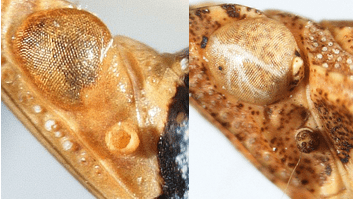
Callosity behind eye: Acinaca lurida (left, callosity absent) and Orgerius concordus (right, callosity present).
7. Vertex short, less than twice the length of the eyes … Orgerius Stål
7.’ Vertex elongate, more than twice the length of the eyes … 8

Deserta obscura (left), Orgamara argentia (middle) and Yucanda albida (right) (Orgeriinae), dorsal view showing elongated head.
8. Cephalic process, as seen from side, beak-like, the apex obliquely rounding from above, the lower angle slightly produced … Deserta Ball
8.’ Cephalic process, as seen from the side, truncate at the extremity, five angled … 9
9. Cephalic process gradually tapering, as seen from top and side … Orgamara Ball
9.’ Cephalic process parallel margined; apex, as seen from the side, slightly enlarged, projecting at an angle with the vertex …Yucanda Ball & Hartzell
10. Head angulate in lateral view, produced in front of eyes for distance greater than 2/3 width of eyes; head widening toward apex … Acinaca Ball & Hartzell
10.’ Head rounded or angulate, produced in front of eyes for distance less than 2.3 width of eyes… 11
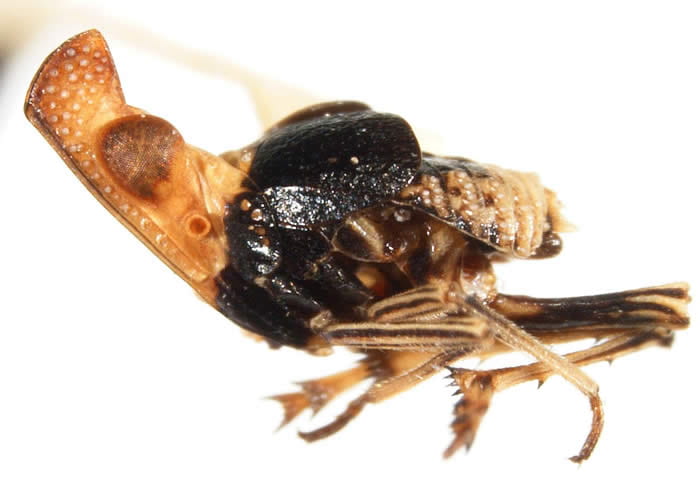
Acinaca lurida (Orgeriinae); Photo by Rick Donovall, University of Delaware, Department of Entomology)
11. Vertex broad and short; apical cell of vertex (areolet) absent; front usually with horizontal black band above frontoclypeal suture; fore and middle tibiae sometimes foliaceous … 12
11.’ Vertex longer, apical cell of vertex (areolet) present; front without horizontal black band above frontoclypeal suture; tibiae not foliaceous … 13
12. Front with horizontal black band above frontoclypeal suture; pronotum without lateral carinae, posterior margin shallowly concave; forewing with median and claval veins as evident carinae … Ticida Uhler
12.’ Front without horizontal black band above frontoclypeal suture; pronotum with lateral carinae, posterior margin deeply U-shaped; forewing with uniform net of veins … Ticrania Emeljanov
13. Areolet well defined, pentagonal, enclosed by sharp carinae … Aridia Ball & Hartzell
13.’ Areolet poorly defined, oval, enclosed by swollen carinae … Timonidia Ball & Hartzell

Ticida cingulata (top) and Ticida (Timodema) miracula (bottom) (Orgeriinae); Photos by Rick Donovall, University of Delaware, Department of Entomology)
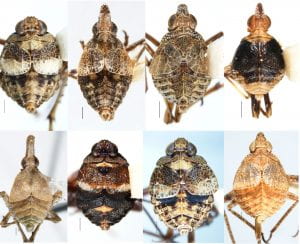
Aridia compressa (left), Ticrania chamberlini (middle, holotype), and Timonidia solitania (right); photo of Aridia compressa by Rick Donovall, University of Delaware, Department of Entomology); photo of holotype of Ticrania chamberlini courtesy Norm Penny, Department of Entomology, California Academy of Sciences); photo of Timonidia solitania by Kimberley Shropshire, Department of Entomology, University of Delaware.
Select References
Ball, E. D. 1909. Some remarkable new leafhoppers of the family Fulgoridae. Proceedings of the Biological Society of Washington 22: 197-204.
Ball, E. D. 1930. The toadhoppers of the genus Phylloscelis Germ. (Rhynchota Fulgoridae). Canadian Entomologist 62: 192-195.
Ball, E. D. 1937. Some new Fulgoridae from Western United States. Bulletin of the Brooklyn Entomological Society 32: 171-183.
Ball, E. D. and A. Hartzell. 1922. A review of the desert leafhoppers of the Orgerini (Rhynchota Fulgoridae). Annals of the Entomological Society of America 15: 137-152.
Bartlett, C. R., E. R. Adams and A. T. Gonzon jr. 2011. Planthoppers of Delaware (Hemiptera, Fulgoroidea), excluding Delphacidae, with species incidence from adjacent States. ZooKeys 83: 1-42.
Bartlett, C. R., L. B. O’Brien and S. W. Wilson. 2014. A review of the planthoppers (Hemiptera: Fulgoroidea) of the United States. Memoirs of the American Entomological Society 50: 1-287.
Bourgoin, T. 2016. FLOW (Fulgoromorpha Lists on The Web): a world knowledge base dedicated to Fulgoromorpha. Version 8, updated 2016-09-15. http://flow.snv.jussieu.fr/ (accessed Sept. 29, 2016)..
Breakey, E. P. 1928. The genus Scolops (Homoptera, Fulgoridae). University of Kansas Science Bulletin 18(6): 417-455.
Cordo, H. A. 1999. New agents for biological control of water hyacinth. Pp. 68-74. In: M. P. Hill, M. H. Julien, and T. D. Center (eds.). Proceedings of the first IOBC Water Hyacinth Working Group. Harare, Zimbabwe, November, 1998.
Doering, K. C. 1955. Some taxonomic and morphological studies of two genera of North American Dictyopharidae.University of Kansas Science Bulletin 37(7): 195-221.
Doering, K. C. and H. H. Darby. 1943. A contribution to the taxonomy of the genus Orgerius in America, north of Mexico (Fulgoridae, Homoptera). Journal of the Kansas Entomological Society 16(2-3): 64-98.
Donovall, L. R., III. 2008. A generic revision of the new world Dictyopharinae (Hemiptera: Dictyopharidae). Masters Thesis. University of Delaware, Newark, Delaware. thesis
Emeljanov, A. F. 1979. [The problem of family distinction between the Fulgoridae and the Dictyopharidae (Homoptera, Auchenorrhyncha)] Trudy Zoologicheskogo Instituta 82: 3-22. [in Russian]
Emeljanov, A. F. 1983. Dictyopharidae from the Cretaceous deposits on the Taymyr Peninsula (Insecta, Homoptera). Paleontologicheskii Zhurnal 1983(3): 79-85 (In Russian; English translation: Paleontological Journal 1983, 17: 77-82).
Emeljanov, A. F. 2006. Taxonomic changes in American Orgeriinae (Homoptera; Dictyopharidae). Zoosystematica Rossica 15:73-76.
Emeljanov, A. F. 2008. New genera and new species of the family Dictyopharidae (Homoptera), with notes on the systematics of the subfamily Dictyopharinae. Entomological Review 88: 296-328.
Emeljanov, A. F. 2010. A new genus of the family Dictyopharidae (Homoptera) from Argentina. Entomological Review 90(6): 724-726.
Emeljanov, A. F. 2011. Improved tribal delimitation of the subfamily Dictyopharinae and description of new genera and new species (Homoptera, Fulgoroidea, Dictyopharidae). Entomologicheskoe Obozrenie 90(2): 299-328 [In Russian, English Translation, Entomological Review 91(9): 1122-1145].
Fennah, R. G. 1944. New Dictyopharidae from the New World (Homoptera: Fulgoroidea). Proceedings of the Biological Society of Washington 57: 77-94.
Fennah, R. G. 1947. Notes on Neotropical Dictyopharidae and synonomy in two other groups. Smithsonian Miscellaneous Collections 107 (3904): 1-15
Fieber, F. X. 1872. Katalog der europäischen Cicadinen, nach Originalien und Benützung der neuesten Literatur. Carl Gerold, Wien. Pp. I-IV, 1-19.
Germar, E. F. 1839. Drei neue Gattungen der Cicadinen, aufgestellt vom herausgeber. Zeitschrift für die Entomologie, herausgegeben von Ernst Friedrich Germar 1: 187-192.
Hernandez, M. C., J. Sacco and G. C.Walsh. 2011. Biology and host preference of the planthopper Taosa longula(Hemiptera: Dictyopharidae), a candidate for biocontrol of water hyacinth. Biocontrol Science and Technology 21(9): 1079-1090.
Hernandez, M. C., M. E. Brentassi, A. J. Sosa, J. Sacco and G. Elsesser. 2011. Feeding behavior and spatial distribution of two planthoppers, Megamelus scutellaris (Delphacidae) and Taosa longula (Dictyopharidae), on water hyacinth. Biocontrol Science and Technology 21(7/8): 941-952.
Kirkaldy, G. W. 1907. Notes on Central American hemipterous fauna. Canadian Entomologist 39: 248-250.
McPherson, K. R. 1994. The dictyopharid planthopper genus Phylloscelis in the United States with notes on the biology and immatures of P. pallescens (Homoptera: Fulgoroidea). Thesis, Central Missouri State University. Master’s Thesis. 84 pp.
McPherson, K. R. and S. W. Wilson. 1995. The planthopper genus Phylloscelis in the United States (Homoptera: Dictyopharidae). Insecta Mundi 9(3-4): 177-188.
McPherson, K. R. and S. W. Wilson. 1996. Life history and descriptions of immatures of the dictyopharid planthopperPhylloscelis pallescens (Homoptera: Fulgoroidea). Journal of the New York Entomological Society 103: 170-179.
Metcalf, Z. P. 1946. General Catalogue of the Homoptera. Fascicle IV Fulgoroidea. Part 8 Dictyopharidae. Smith College, Northhampton, Massachusetts.
O’Brien, L. B. 1999. New species of Toropa and Igava and new genus, Trigava gen.n. (Hemiptera: Auchenorrhyncha: Fulgoroidea: Dictyopharidae). Reichenbachia 33(1): 56-60.
Onuki, S. 1901. [Study of the Homoptera injurious to the rice fields.]. [Special Report of the Agricultural Experiment Station, Nishigahara. Tokio] 10:[1-74]. [in Japanese]
Pulz, C. E. and G. S. Carvalho. 2006. As espécies de Nersia (Hemiptera, Fulgoromorpha, Dictyopharidae) do Rio Grande do Sul, Brasil. [The species of Nersia (Hemiptera, Fulgoromorpha, Dictyopharidae) from Rio Grande do Sul, Brazil]. Iheringia. Série Zoologia 96(1): 75-80. pdf
Pulz, C. E. and G. S. Carvalho. 2003. Redescrição de Melicharoptera polyneura (Berg, 1883) e novos registros para o Brasil (Hemiptera, Dictyopharidae). Pesquisa Agropecuária Gaúcha 9(1-2): 165-170.
Remes-Lenicov, A.M.M. de and M. C. Hernandez. 2010. A New Species of Taosa (Hemiptera: Dictyopharidae) From South America Associated With Water Hyacinth. Annals of the Entomological Society of America 103(3): 332-340.
Say, T. 1825. Descriptions of new hemipterous insects collected in the expedition to the Rocky Mountains, performed by order of Mr. Calhoun, Secretary of War, under command of Major Long. Journal of the Academy of Natural Sciences of Philadelphia 4: 307-345.
Schaum, H. R. 1850. Fulgorellae. Allegemeine Encyklopädie der Wissenschaften und Kunste in alnhaberischen folge von Genannten Schriftstellern bearbeitet und herausgegeben von I. S. Ersch und I. G. Gruber mit Kupfern und Charten. Erster Section A -G. 51: 58-73.
Stål, C. 1859. Hemiptera. Species novas descripsit. In: Konglinga svenska Fregatten Eugenies resa omkring jorden under befäl af C. A. Virgin åren 1851-1853. Vetenskapliga iakttagelser På H. Maj: t Konung Oscar den Förstes befallning utgifna af K. Svenska Vetenskaps-Akademien Zoologi. P. A. Norstedt & Söner. Stockholm. 4: 219-298.
Stål, C. 1862. Bidrag till Rio Janeiro-traktens Hemipter-fauna. II. Svenska vetenskaps-akademiens handlingar 3 (6): 1-75.
Triapitsyn, S. V. and M. C. Hernández. 2011. Parasitoides oófagos de Taosa spp. (Hemiptera: Dictyopharidae) en Formosa, Argentina, y descripción de dos nuevas especies. [Egg parasitoids of Taosa spp. (Hemiptera: Dictyopharidae) in Formosa, Argentina, with descriptions of two new species.] Revista de la Sociedad Entomológica Argentina 70(1-2): 55-61.
Uhler, P. R. 1891. Remarkable new Homoptera. Transactions of the Maryland Academy of Sciences 1: 143-147.
Urban J. M. and J. R. Cryan. 2009. Entomologically famous, evolutionarily unexplored: The first phylogeny of the lanternfly family Fulgoridae (Insecta: Hemiptera: Fulgoroidea). Molecular Phylogenetics and Evolution 50: 471-484.
Van Duzee, E. P. 1916. Suborder Homoptera Latr. 1810. Section Auchenorhyncha A. & S. 1843. In: Check list of Hemiptera (excepting the Aphididae, Aleurodidae and Coccidae) of America north of Mexico. New York Entomological Society, New York. pp.: i-xi, 1-111.
Van Duzee, E. P. 1934. An interesting new fulgorid (Hemiptera). Pan Pacific Entomologist 10(4): 191-192.
Wilson, S. W. and A. G. Wheeler jr. 2005. An African grass, Eragrostis curvula (Poaceae), planted in the southern United States recruits rarely collected native planthoppers (Hemiptera: Fulgoroidea: Dictyopharidae, Fulgoridae). Journal of the New York Entomological Society 113(3-4): 174-204.
Wilson, S. W. and J. E. McPherson. 1981. Notes on the biology of Nersia florens (Homoptera: Fulgoroidea: Dictyopharidae) with descriptions of eggs, and first, second and fifth instars. Great Lakes Entomologist 14(1): 45-48.
Wilson, S. W., C. Mitter, R. F. Denno and M. R. Wilson. 1994. Evolutionary patterns of host plant use by delphacid planthoppers and their relatives. pp. 7-113. In: R. F. Denno and T. J. Perfect (eds.). Planthoppers: Their Ecology and Management. Chapman and Hall, New York.


